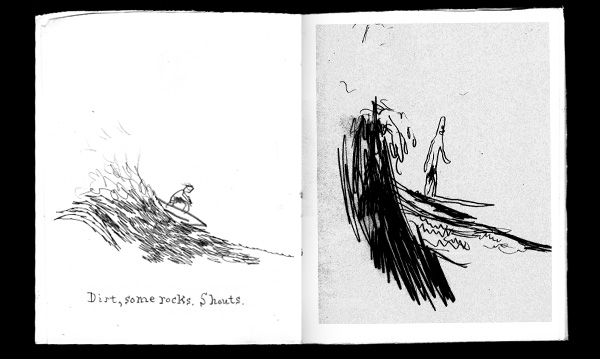
Based on Sergio Leone's 1968 Western Once Upon a Time in the West and drawn in André Lemos' characteristic heavy-brush style, O Percutor Harmonico is a sort of translation of the opening scene of the film, though not at all a straight re-telling. There are no words - in the art alone Lemos skates on the surface of Leone's work, picking and plucking and placing images in an order that creates something new alongside the original story.

O Percutor Harmonico opens with a Lemos version of the Paramount logo making it clear that he's drawing from a film. Once Upon a Time in the West is famous for being full of references to other Westerns so it works well that Lemos is choosing his own motifs and references to play with. A train, dusters, a windmill and of course, cowboy hats. There's also, just once, a harmonica, something very important to the original film.

This way of translation reminds me of a song by "Mole" called "Monument Valley. The lyrics are lines pulled from (I think) John Ford's classic Western Fort Apache, but they are similarly plucked and reshaped to make something that is certainly of the original piece but something wholly new as well.

Lemos' art fits the gritty dirty subject well with his careening violent brushwork. The images don't clearly or easily tell the story, but they add up anyway. There's a slim thread of a narrative (a train arrives, some guys face off, a gunfight), but Lemos doesn't open a window for us to gape though - he re-edits the film in ways that don't always seem to make sense and gives us an experience that we find, one that we piece together. This is close to an Eisensteinian way of making comics - drawing not only from film's more obvious narrative capacity but also from it's mysterious juxtaposing power.

I'm not sure how one could get O Percutor Harmonico other than to email Lemos directly though his Opuntia Books site. Here's a review by Portuguese critic Pedro Moura. O Percutor Harmonico is published by AO Norte. All these sites are in Portuguese. I should add that since I can't read Portuguese, and the essay in the book is in Portuguese, I may be missing something critical about the whole project. I like being confused though, so this language barrier has not been a problem for me.
All images © André Lemos. "Monument Valley" is © Mole - if you are Mole and want me to take it down I will but I couldn't find you online anywhere to ask permission. I hope you're ok with me spreading your glory.






















